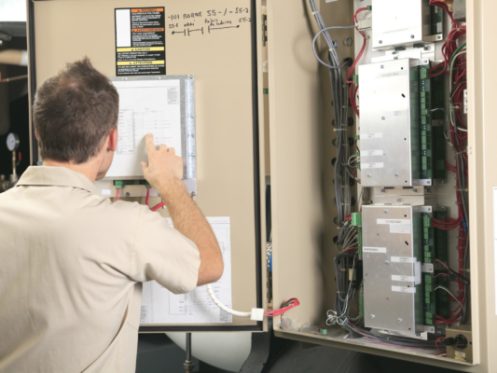Understanding the Role of a Furnace Limit Switch
Cold winters in St. Peters would be hard to handle without the help of a good furnace. While the furnace in your home may seem simple, it’s actually a complex piece of equipment. One major concern that furnace manufacturers have to manage is ensuring that the furnaces they manufacture don’t do damage to the homes where they’re installed. To achieve this goal, furnaces come with a variety of safety features, one of which is called the furnace limit switch. To better understand the purpose of this device and make sure that your own furnace is safe to use, check out this guide from your friends at Jerry Kelly Heating & Air Conditioning.
Main Function of a Furnace Limit Switch
The main role of a furnace limit switch is to detect the temperature inside a furnace. In a single-stage furnace, the limit switch is typically located inside the furnace just below the plenum. The plenum is the metal box that’s part of the ductwork above the furnace and is the first place that the heated air passes through after it leaves your furnace. Inside the limit switch is a metal coil that expands and contracts as its temperature changes. When the coil reaches the correct size, it is able to complete an electrical circuit so that your furnace can operate. Since the furnace limit switch is located just below the plenum, it can accurately assess the temperature of the air that’s blowing into your home.
Cycling Your Furnace
Your furnace’s limit switch plays a vital role in helping your furnace cycle on and off. Your system’s thermostat connects directly to the gas burners or electric coils that create heat energy. When the thermostat calls for heat, these components are the first to turn on. Meanwhile, the limit switch is silently detecting the temperature inside the furnace itself. Once this temperature reaches a certain point, the limit switch completes the electrical circuit for the blower fan so that your system can blow warm air throughout your home.
At the end of the heating cycle, the thermostat first stops the flow of energy to the burner or heating element. Then, the limit switch works to detect the temperature of the air as it passes by. Once the air cools down so that it’s the same temperature as the air in your home, the limit switch will stop the flow of electricity to the blower fan. This order of operation prevents heat buildup and helps keep your home comfortable.
Protecting Your Furnace
Another important job that the furnace limit switch has is protecting your furnace from overheating. Overheating conditions can occur if your blower fan doesn’t engage to bring down the temperature of the inside of the furnace. Problems can also arise if there are issues with your gas burners or electric heating elements. A furnace’s limit switch is tied to the main logic board of the unit. This means it can tell the furnace to shut down entirely if it senses a problem. Thus, rather than simply stopping the flow of electricity to the blower fan, the furnace can also stop the flow of energy to any heat-producing components of the furnace. If your furnace shuts down unexpectedly, there’s a chance that your furnace limit switch has detected a fault. Rather than ignoring this issue, it’s important to call Jerry Kelly Heating & Air Conditioning to take a look at your furnace.
Signs of Problems
Even when a furnace is operating properly, the furnace limit switch may still prevent it from running. In these cases, it’s typically a fault with the limit switch itself that’s to blame. One sign of a faulty furnace limit switch is if your furnace stops running but the blower fan continues to blow air throughout your home. In this case, it’s likely that the limit switch can’t detect that the interior of the furnace has reached the lower temperature limit. If the switch doesn’t know this condition has been met, it won’t stop the flow of electricity to the blower fan. This problem will quickly cause your house to become cold. Another sign that your furnace’s limit switch is going bad is when your furnace only runs in short cycles. When this happens, it means that the limit switch is working to cycle the furnace but is not sensing the correct temperature. Either of these problems will require a visit from Jerry Kelly Heating & Air Conditioning.
Other Furnace Safety Features
The furnace limit switch isn’t the only component that’s designed to help your furnace operate safely. If you have a gas furnace, there are up to four other safety sensors that work together to shut your furnace down if dangerous conditions occur. The first safety feature is the flame-proving sensor. This sensor makes sure that your gas burner is producing flame so that excess gas doesn’t build up in the combustion chamber. A flame rollout sensor checks to make sure that the flame stays in the combustion chamber instead of exiting the chamber in search of oxygen. The flue exhaust sensor checks to make sure that the system is drawing the exhaust products from your furnace up and out through the flue. Finally, the fan limit sensor monitors the airflow in your furnace to ensure that the fan is blowing normally. It’s important to note that any of these sensors can malfunction. If they do, you need to have them replaced by Jerry Kelly Heating & Air Conditioning as soon as possible so that dangerous conditions don’t go undetected.
Taking Care of Your Limit Switch
Scheduling annual maintenance from Jerry Kelly Heating & Air Conditioning for your furnace is the best way to take care of your furnace’s limit switch. During the maintenance process, a technician will check the wires that lead to and from the switch to make sure they are in good condition. Additionally, the technician will use a multimeter to check the continuity of the switch. A failed continuity test indicates that there is a break in the wiring inside of the switch that will prevent it from working properly. Another easy way to take care of your limit switch is to allow for proper airflow to the switch by replacing your system’s air filter when it’s dirty. Poor airflow could cause your furnace to overheat whether or not the furnace and blower fan are operating properly. Additionally, make sure that all of your return and supply vents are open so that the system doesn’t build up excess air pressure.
Your Furnace Experts
At Jerry Kelly Heating & Air Conditioning, we work hard to maintain and enhance our knowledge of furnaces all the time. We do this to provide outstanding results to every customer we serve. Other ways we serve our customers include air conditioner installation, whole-home air purifier maintenance, thermostat repair, water heater replacement, and much more. For over 45 years, we’ve been taking care of this community to ensure that as many people as possible can stay comfortable in their homes. That’s why we’ve received the St. Louis Post-Dispatch Best of St. Charles in the Heating & Cooling category multiple times. It’s also why we continue to receive five-star customer reviews. To learn more about furnaces, contact us at Jerry Kelly Heating & Air Conditioning today.

